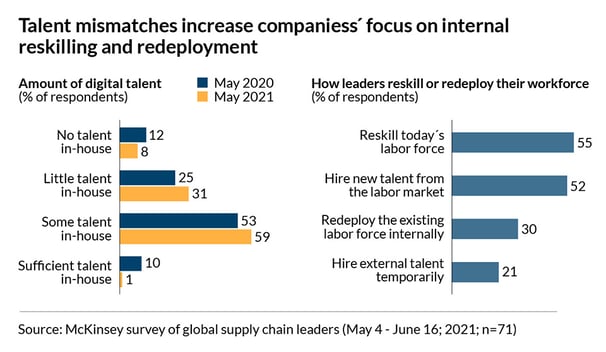Five Steps to Supply Chain Digital Success
Keith LaBotz - November 10, 2022

“The journey of a thousand miles begins with one step” - Lao Tzu, Chinese Philosopher.
Every step matters in a thousand-mile journey; without a good map, one misstep can take you far from your destination. The same is true when digitally transforming a supply chain: starting with a map can prevent the overwhelming odds of straying into problems.
According to McKinsey, BCG, KPMG, and Bain & Company, 70% to 95% of transformational projects fail. Most digital initiatives start with high hopes and a bullish belief in new technologies. The vision of a transparent, agile supply chain drives many companies, but they end up with a tangled web of sourcing, planning, and execution technologies.
Finding the path back to the original destination requires a roadmap, which will take a more skilled team in digital technologies. Getting this team will be difficult, and it may still be too little too late.
 There is a shortage of in-house digital supply chain talent to support digitization efforts, increasing the risk of failure and slowing down new initiatives. Another McKinsey survey had 99 percent of respondents indicating their company lacked sufficient digital talent to implement solutions. A company can avoid this by matching available resources with desired capabilities before charging ahead with a solution it’s unable to support.
There is a shortage of in-house digital supply chain talent to support digitization efforts, increasing the risk of failure and slowing down new initiatives. Another McKinsey survey had 99 percent of respondents indicating their company lacked sufficient digital talent to implement solutions. A company can avoid this by matching available resources with desired capabilities before charging ahead with a solution it’s unable to support.
Digitization efforts can only succeed by following a practical roadmap. Creating this map upfront is far easier, less costly, and lower risk than backtracking after the fact. Appropriately done, creating a roadmap for a digital supply chain will:
- Ensure process improvements conclude with the functionality envisioned.
- Increase process modularity, agility, integration, and data visibility.
- Facilitate quicker, less costly, and more effective implementation of technologies.
- Satisfy immediate and future business requirements like increasing profitability, sustainability, and improving customer experience.
- Significantly reduce the risk of project failure.
It does not matter how far down the road a company is with its digitalization effort - the chances of success increase the sooner a roadmap is utilized. Let’s outline the steps for creating a practical roadmap when digitally transforming a supply chain.
Step 1: Identify Stakeholders
Supply chain stakeholders are the parties your company must satisfy to sustain operations. They include customers, government regulators, vendors, suppliers, employees, shareholders, management, and other parties. Each stakeholder expects your company to meet specific financial, legal, procedural, logistical, and informational inputs and outputs.
Step 2: Identify Business Requirements (Stakeholder Expectations)
The entire supply chain process - the data structure, functionality, technology, and business strategies serves one purpose: to fulfill stakeholder expectations. Also known as business requirements, process improvements are ultimately about satisfying them with minimal cost, time, and risk.
Consider the business requirements a single stakeholder, a transportation carrier, that a company must meet when shipping orders:
- Shipments must fall within a specified weight range and packaging.
- There are unique procedures this vendor uses for costing, labeling, packaging, tendering, tracking, and payment for shipments.
- Government-regulated shipping documents must be provided to the carrier.
Business requirements take significant effort to document. Most are available in your current supply chain process but scattered across different departments.
The easiest way to gather requirements is to appoint a subject matter expert in the department who can demonstrate how a process works and identify needed data. Organizing them into a comprehensive document that links each to a stakeholder requires a subject matter expert.
The effort invested in requirements gathering impacts everything else when improving a supply chain process. For this reason, successful projects are more thorough in this analysis, and short-cutting increases the risk of failure.
Step 3: Identify Current and Future Functionality
Functional capabilities describe how your business process operates to satisfy business requirements documented in Step 2 now and in the future. Examining system transactions and workflow reveals current functionality, which is the starting point in the digitalization journey.
Future process improvements represent the destination(s) mapped and usually begin as proposed process improvements from various sources:
- Future business requirements from stakeholders.
- “Must-have” capabilities to achieve business objectives.
- Talking to current users (the best source).
- Internal business process analysis.
- Consultant recommendations.
- Industry blog posts and watching vendor product demos.
- Brainstorming with team members over a cold beer.
Regardless of inspirational sources, process improvements begin with asking the right questions about the current process. For example, looking at transportation routing, a few questions might include:
- What would a single routing process for all modes of transportation and carriers look like, and how would it work?
- What data can be integrated from other sources to improve routing decisions?
- What steps can we eliminate and automate with the data?
- Is it more cost-effective to outsource all or part of our delivery operation?
- How can we utilize software to optimize live routing and what-if scenarios to find new opportunities?
- What changes can reduce fuel consumption and increase equipment utilization?
Step 4: Account for Current Resources
With future functionality identified, your company must determine whether it has the resources needed: the tools, data, staff, time, budget, and vendor relationships needed to support a solution. Discussions with solution providers will furnish the answers, allowing your company to match its resources to functionality.
Step 5: Create a Digital Roadmap
The final step of creating a roadmap will guide improvements across the enterprise toward a single vision. In the interest of brevity, I’ll outline the mapping process and cover it in greater detail in a future blog.
- Map Current and Future Processes. Define the most effective path from the current process to future functionality
- Eliminate Gaps and Overlaps. Minimize process steps by eliminating duplicated effort and ensuring support for future functionality.
- Build a Unified Data Model. Establish a single, global data model for the enterprise.
- Integrate Technologies. Integrate new technologies to support new functionality around the unified data model.
Conclusion
Every successful digitization initiative follows a roadmap; the only question is when a company realizes this need. Creating a roadmap to digitalization before selecting and implementing digital technologies is far easier than correcting the consequences of not doing it. It’s never too late to make a map.
flexis AG provides a suite of products and services that make mapping supply chain digitization easier for companies.
INTERESTED IN MORE INFORMATION?
LATEST POSTS
- Understand Circular Economy in The Manufacturing Industry
- How Can Industry 4.0 IT Integration Be Achieved Smoothly?
- The Significance of Order Sequencing in Discrete Manufacturing
- How to improve your Supply Chain Management: The Power of Control Towers
- Optimizing Human Resource Scheduling in Manufacturing: A Technological Approach



